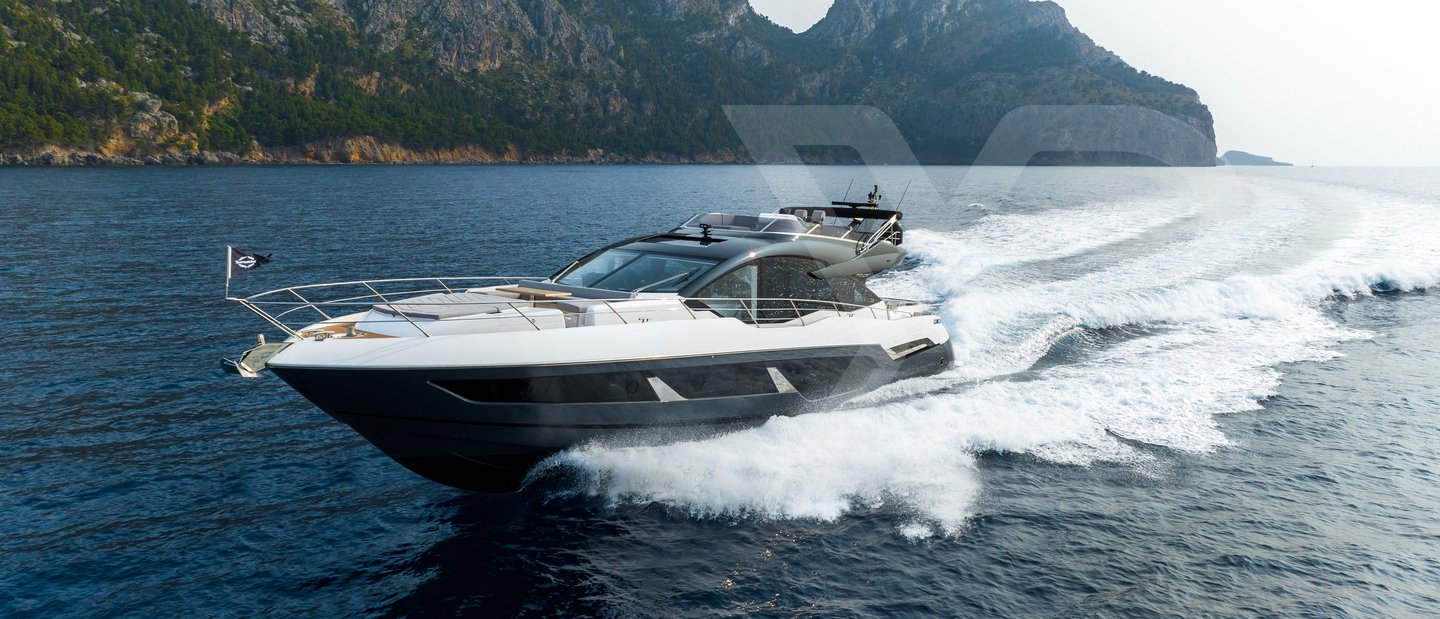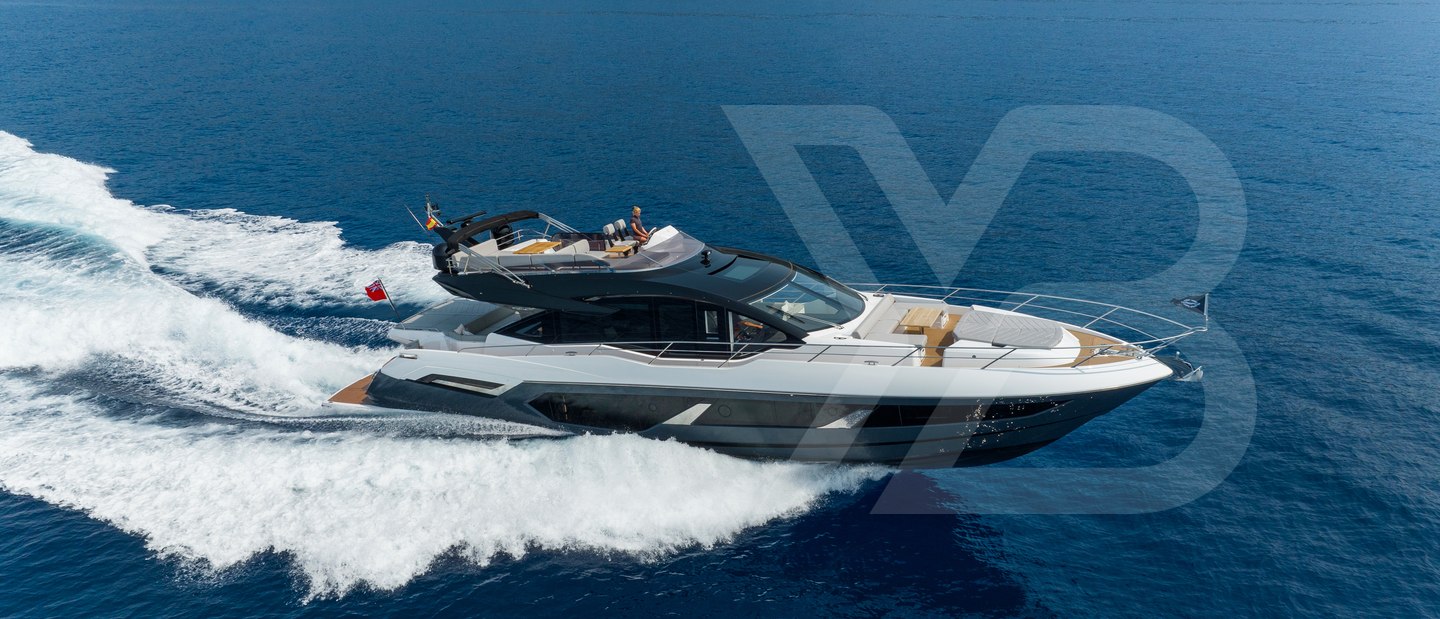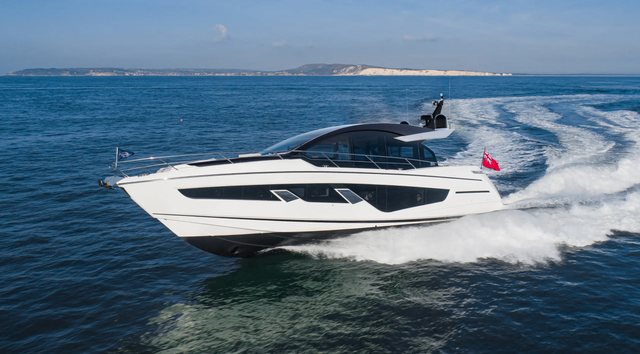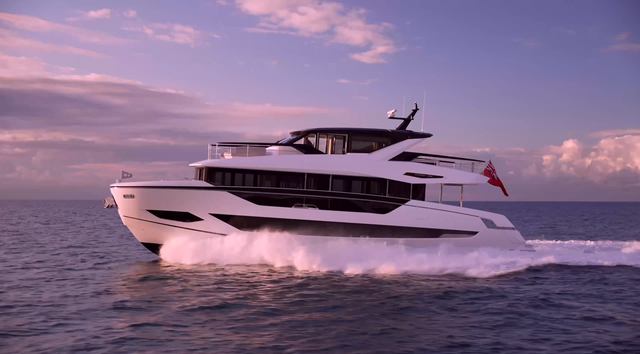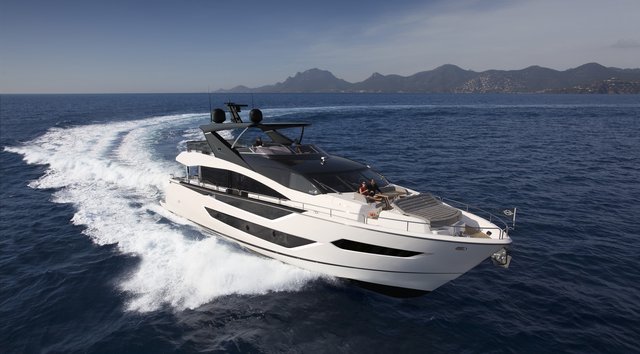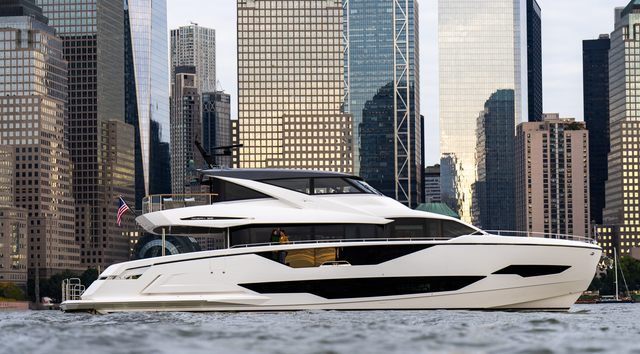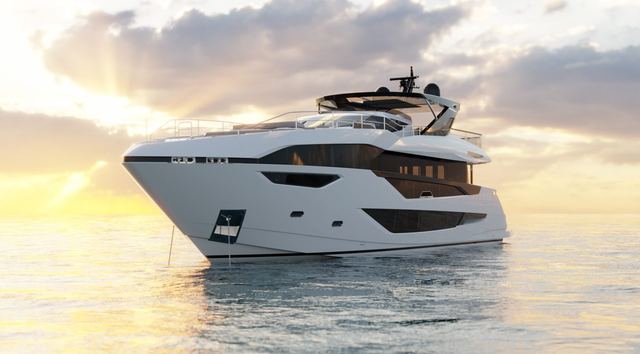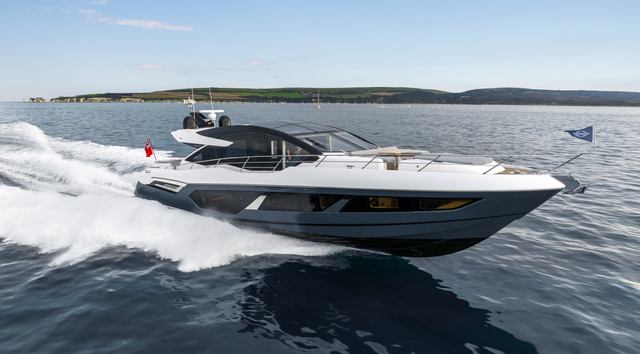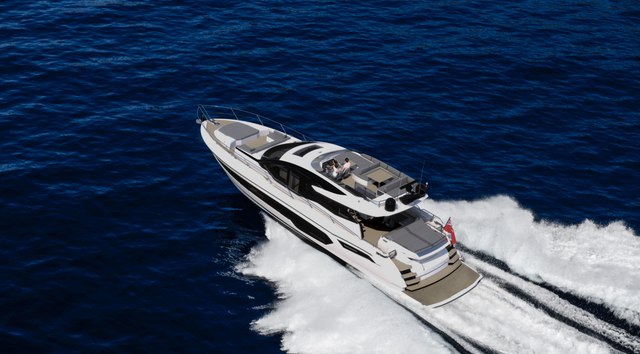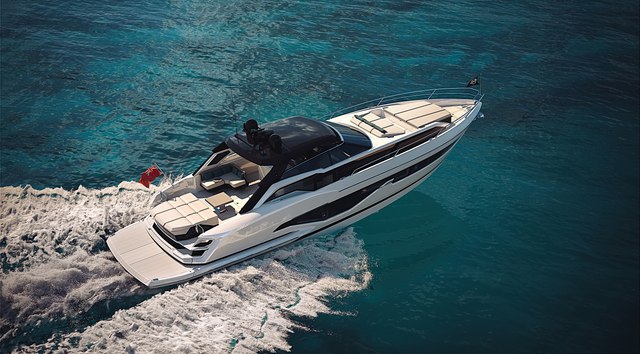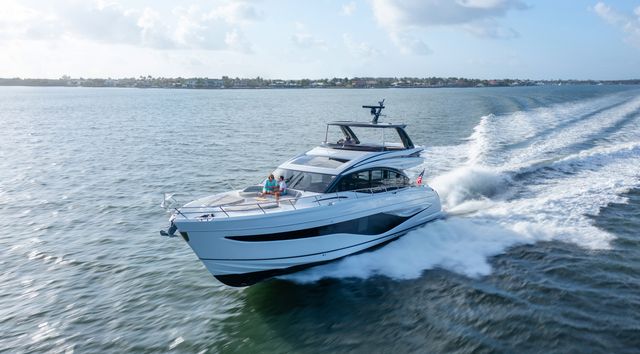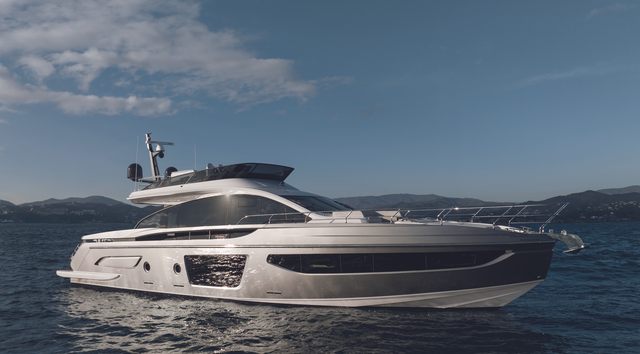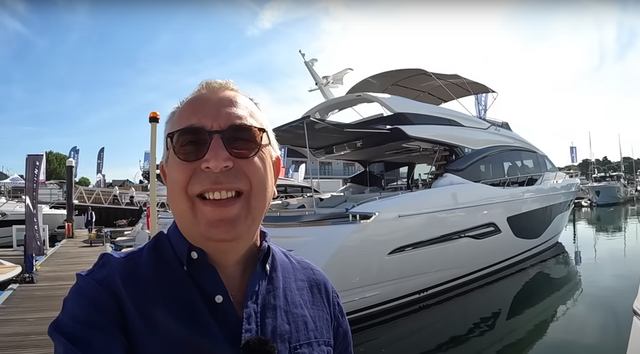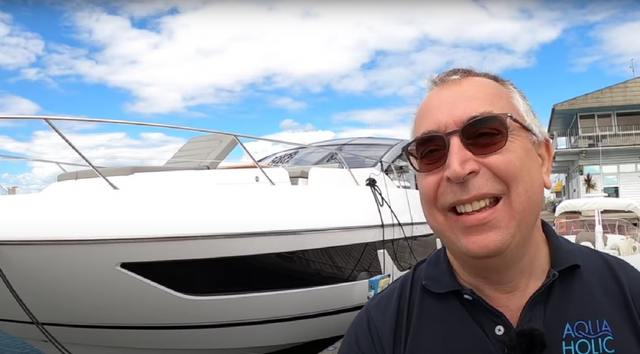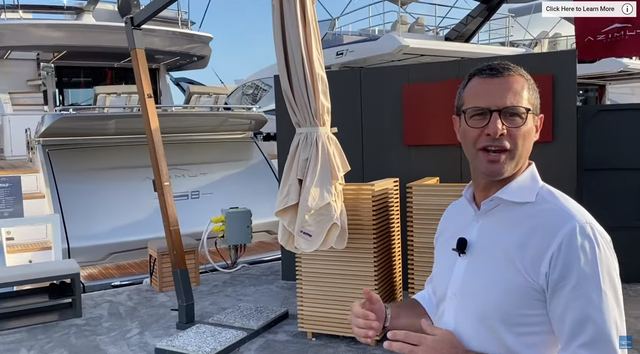First unveiled at the Düsseldorf Boat Show 2023, the Sunseeker 75 Sport Yacht follows Sunseeker's proven two-model setup. Buyers can choose between the open sport bridge layout or the enclosed Predator version.
Both sit on the same high-performance hull, featuring a reshaped transom and an upgraded RCD category A rating - the highest standard for leisure yachts in European waters. Despite being classed as a sportsbridge, the upper deck feels closer to flybridge standards in terms of comfort and spec, and it’s among the largest in this size range. Inside, the layout prioritises open salon space on the main deck, with the galley and dinette positioned below, which works well, though it does define the boat as a three-cabin model in standard form.
Sunseeker 75 Sport Yacht Key Facts

- LOA 75' 8"
- Model Year 2025
- Cabins 3
- Crew 2
- Max Speed 40 knots
- Status In Production
- Yacht Type Sportsbridge
- Use Type Cruising
The 75 Sport Yacht builds on the same platform as the 74, keeping the proven hull, engineering setup, and layout, but with a series of technical and cosmetic refinements that push the design further. Twin 1,900hp MAN V12 engines deliver serious pace, topping out close to 40 knots, with a fast cruise around 25 knots. Interceptor trim tabs, proportional thrusters, and Vector fin stabilisers combine to keep handling tight and the ride stable, both underway and at rest.
The boat now meets RCD Category A standards, thanks to structural upgrades that include reinforced deck construction and improved down-flooding protection. Sunseeker has done this without changing the running characteristics, so you should still get the same confident handling and performance.
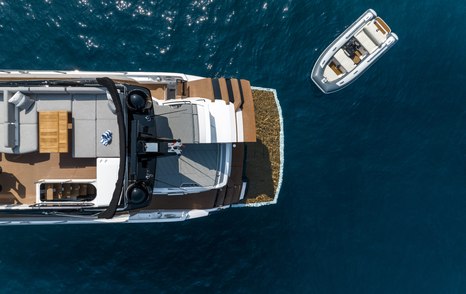
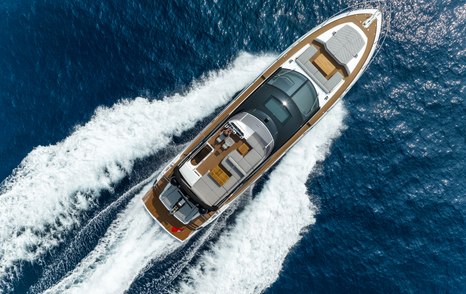
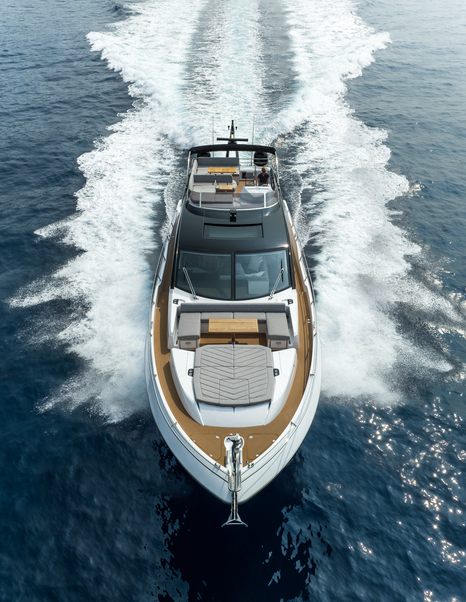
Above the deck, the new transom layout introduces symmetrical staircases and a central garage door, replacing the previous offset design. The garage still houses a Williams 395 and a Jet Ski, and works in tandem with the hydraulic hi-lo platform. Hull colours have been updated too, with a pigmented gel coat developed to resist heat build-up. On the sportsbridge, a low solar absorption coating helps reduce temperature transfer through the black moulding - a detail borrowed from Sunseeker’s 100 Yacht.
Visibility at the helm has been improved with deeper side glazing, and stainless trim has been added to window sections on the lower deck. Inside, the XPS-style sports interior (formerly an optional upgrade) now comes as standard. You get carbon detailing, sharper finishes, and a more modern, dynamic feel throughout.
Below decks, buyers can opt for a fourth bunk cabin, but most will prefer the standard three-cabin layout, which makes room for a sociable lower dinette. It’s a practical touch that turns the lower deck into more of a liveaboard space, and makes good use of the natural light entering from the windscreen above.
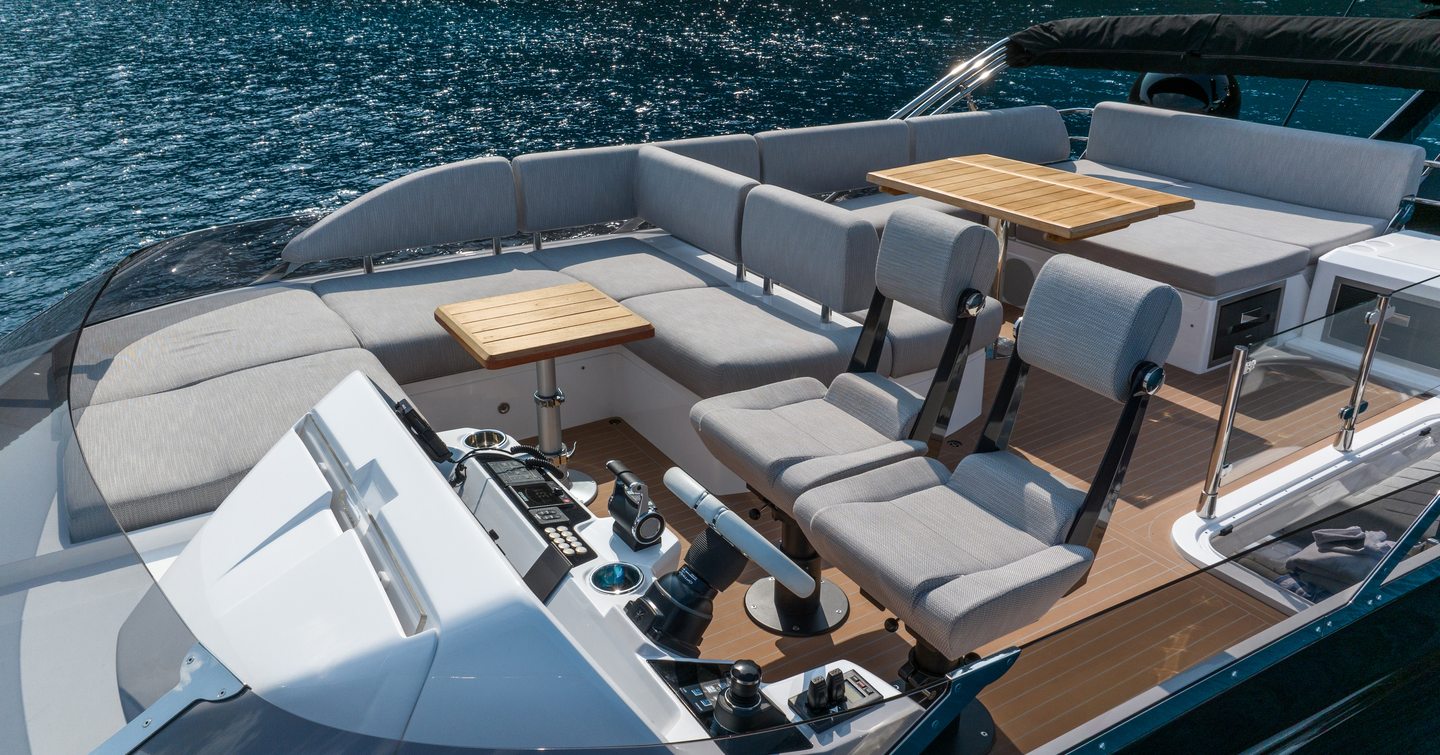
What stands out in the saloon is how effectively it connects with the cockpit. A large glazed panel and sliding door merge the two spaces, and when the door slides aside, the adjacent glass bulkhead section lowers into a recess behind the seating. It's a substantial mechanism, and not a quick one either, but given the size and weight of the glass involved, that's no real surprise. Once stowed, though, the result is worth the wait. The transition between cockpit and saloon becomes almost indiscernible, visually and spatially, and it changes the atmosphere inside.
With the sunroof open, side door ajar, and that rear section dropped, the natural ventilation is exceptional. It creates an open, breezy environment that, in the right conditions, might comfortably rival the air conditioning during the day. At anchor on a warm afternoon, the airflow through this area could be enough to leave the climate control off entirely.
The dinette is generous, with a carbon fibre table that matches the one outside, adjustable in height and folding out when needed. Opposite, there’s built-in storage housing an ice maker, and just behind, a pop-up flat-screen TV. The layout means everyone seated along that stretch gets a clear view. Subtle design elements continue throughout, including detailing inspired by the original Sunseeker logo that appears across various fittings. Even practical items like storage lids are well-finished, with smart stainless steel and carbon fibre accents on the handles.
The L-shaped seating to port makes efficient use of the space, allowing a few extra guests to sit comfortably during passage without obstructing the thoroughfare forward. That route leads directly to the lower helm, which delivers a strong driving environment.
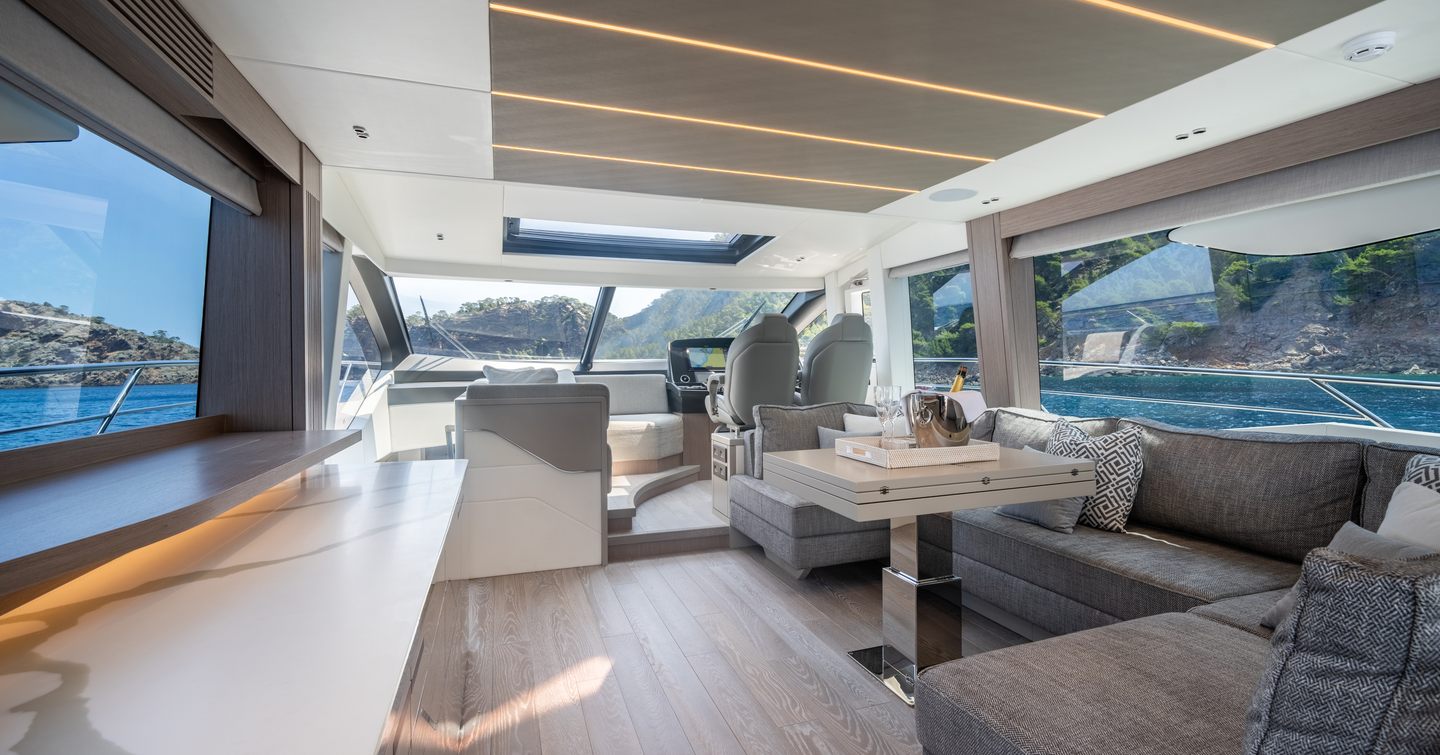
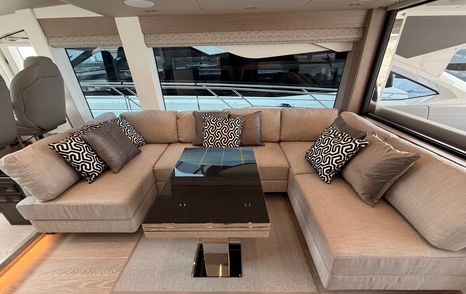
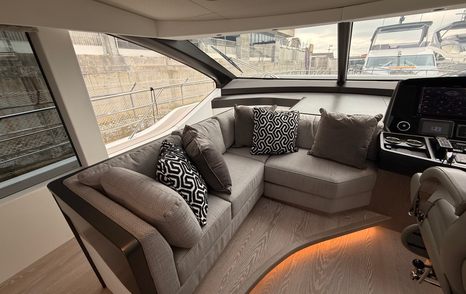
Thanks to the connection to the windscreen above, the lower deck is unusually bright for a space this far below, and the effect lifts the whole area. The galley, dinette, and storage are all down here, but somehow it avoids any sense of feeling closed in.
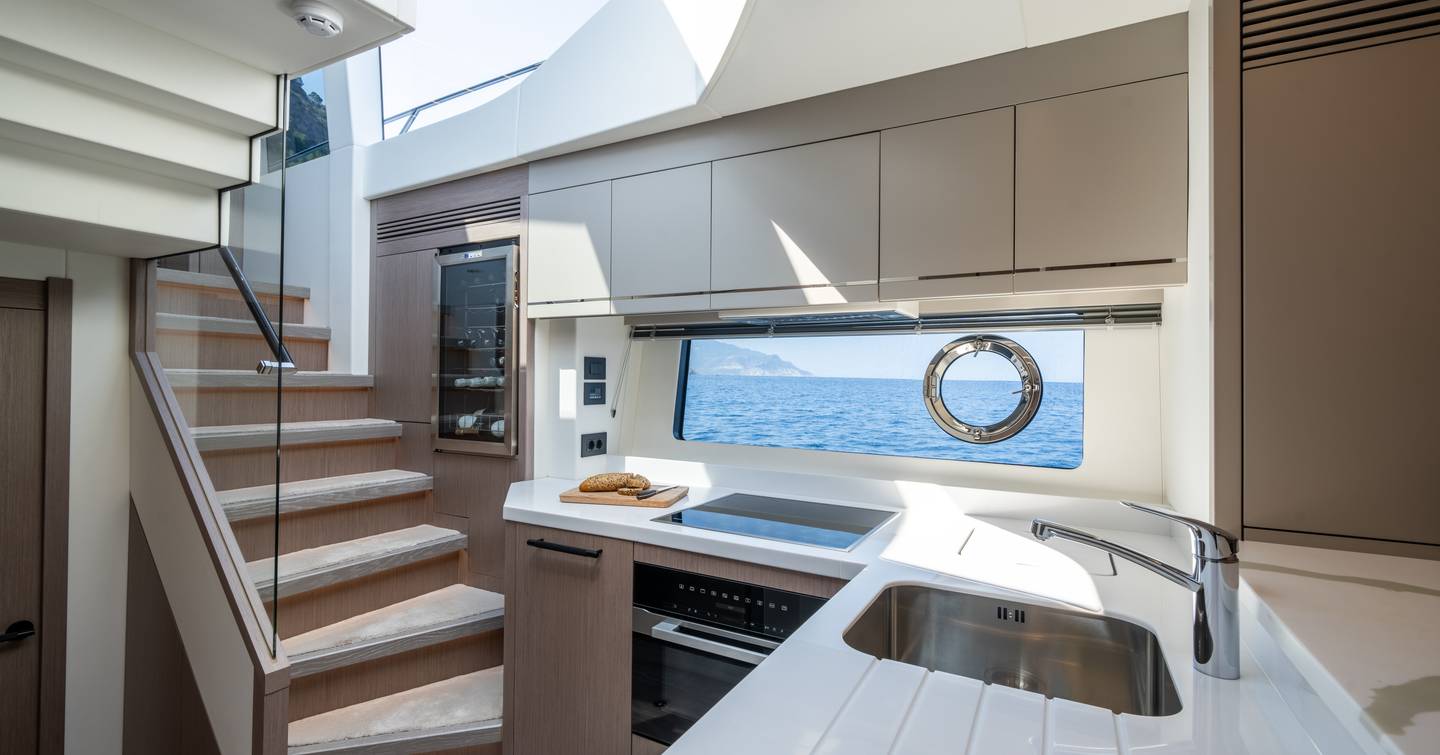
This means the layout leans toward the traditional, with the galley kept below rather than shifted up to the main deck aft as seen on some newer models. That said, it works brilliantly. There’s a generous amount of space, and the spec is strong: induction hob with four burners, extractor, dishwasher, Vitrifrigo standing fridge with freezer drawers, and loads of storage. One of the forward cupboards works particularly well as a pantry - a nice, deep space to stash supplies.
Opposite the galley, the lower dinette creates a useful second living area. It’s a quiet spot for a morning coffee or for the kids to retreat with the TV on the bulkhead. It makes the whole space feel more domestic, more like somewhere to settle in for the weekend. You can spec this area as a bunk cabin if you want to push for four cabins, but it’s hard to argue with the comfort of the current setup. It all just feels easy to live in.
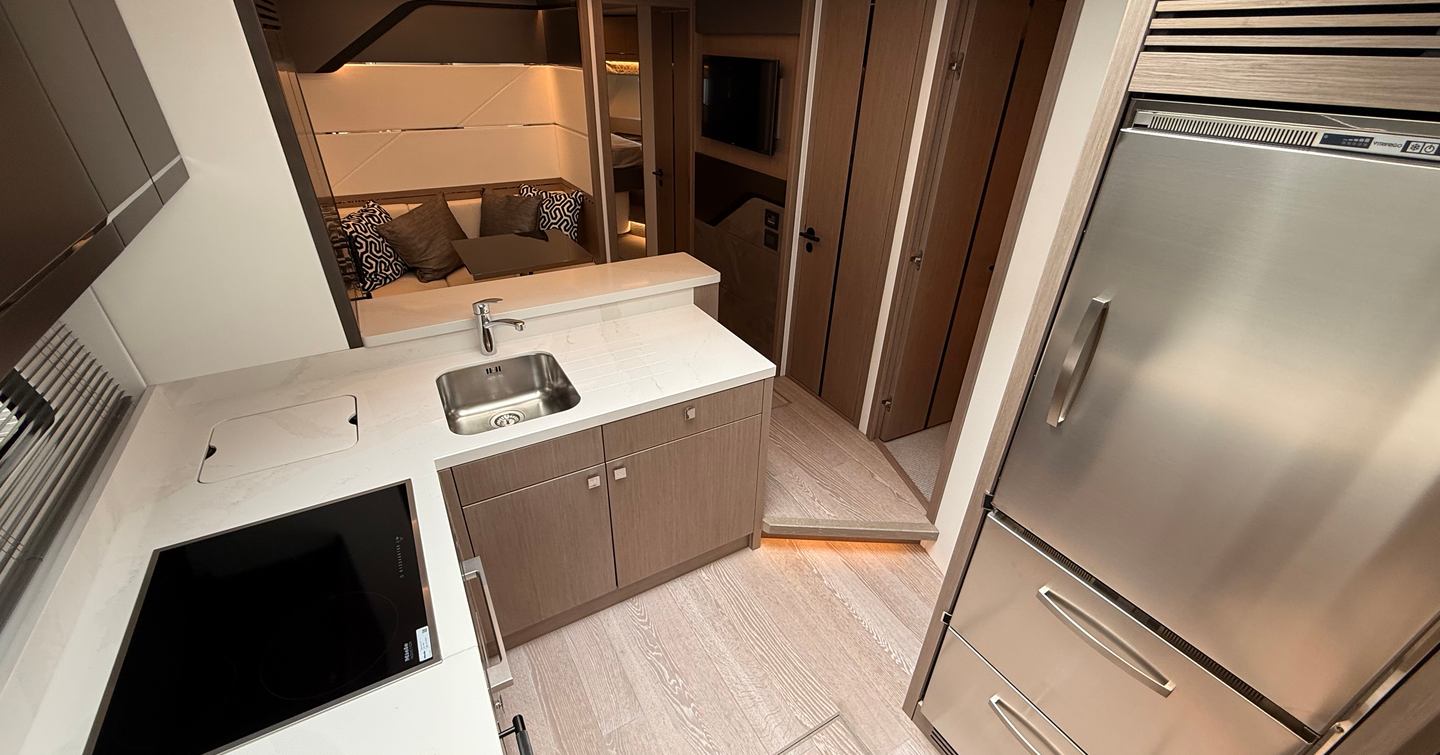
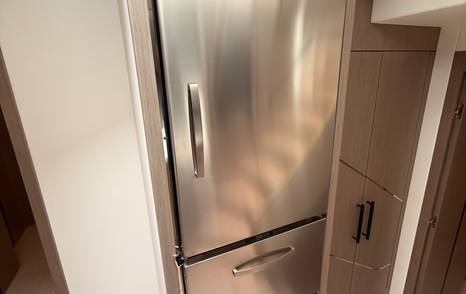
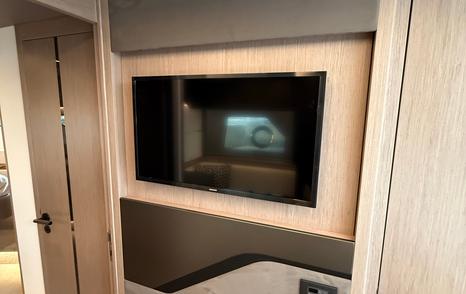
Owner's Cabin
A few steps down leads to the owner’s cabin, positioned amidships and making the most of the yacht’s beam. The floor is completely flat, the headroom is generous, and there’s a large walk-around king-size bed with big, substantial bedside tables on either side. To port sits a private breakfast dinette, a quiet spot to work or unwind with a drink away from the main saloon. Opposite, there’s a bureau and additional storage built into the starboard side.
Large hull windows bring in plenty of light, though visibility will naturally depend on where the boat’s lying. A wall-mounted TV sits opposite the bed, and behind it, two doors lead off - one to a good-sized walk-in wardrobe, and the other to the ensuite. That space is equally generous, with a proper sense of luxury, though the extractor fan is on the loud side. Still, the overall impression is of a well-considered, comfortable cabin with details like the walk-in wardrobe giving it a genuinely private, live-aboard feel.
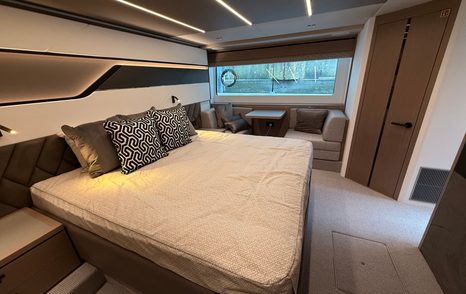
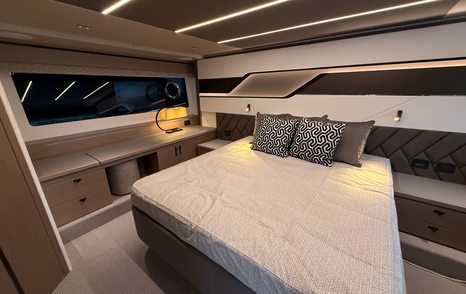
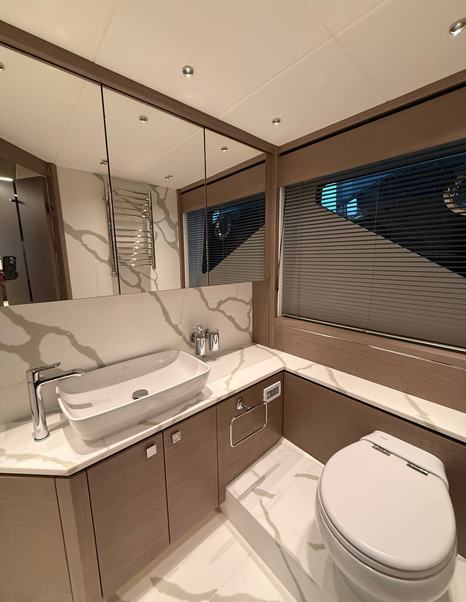
Forward, the VIP cabin makes full use of the yacht’s volume with well over 1.8m (6ft) of headroom throughout. The space includes a wall-mounted TV, bureau, and hanging storage, all finished to a high standard. It’s paired with a private bathroom featuring a separate shower cubicle, a generous basin, a Tecma toilet, and fittings that are all high quality.
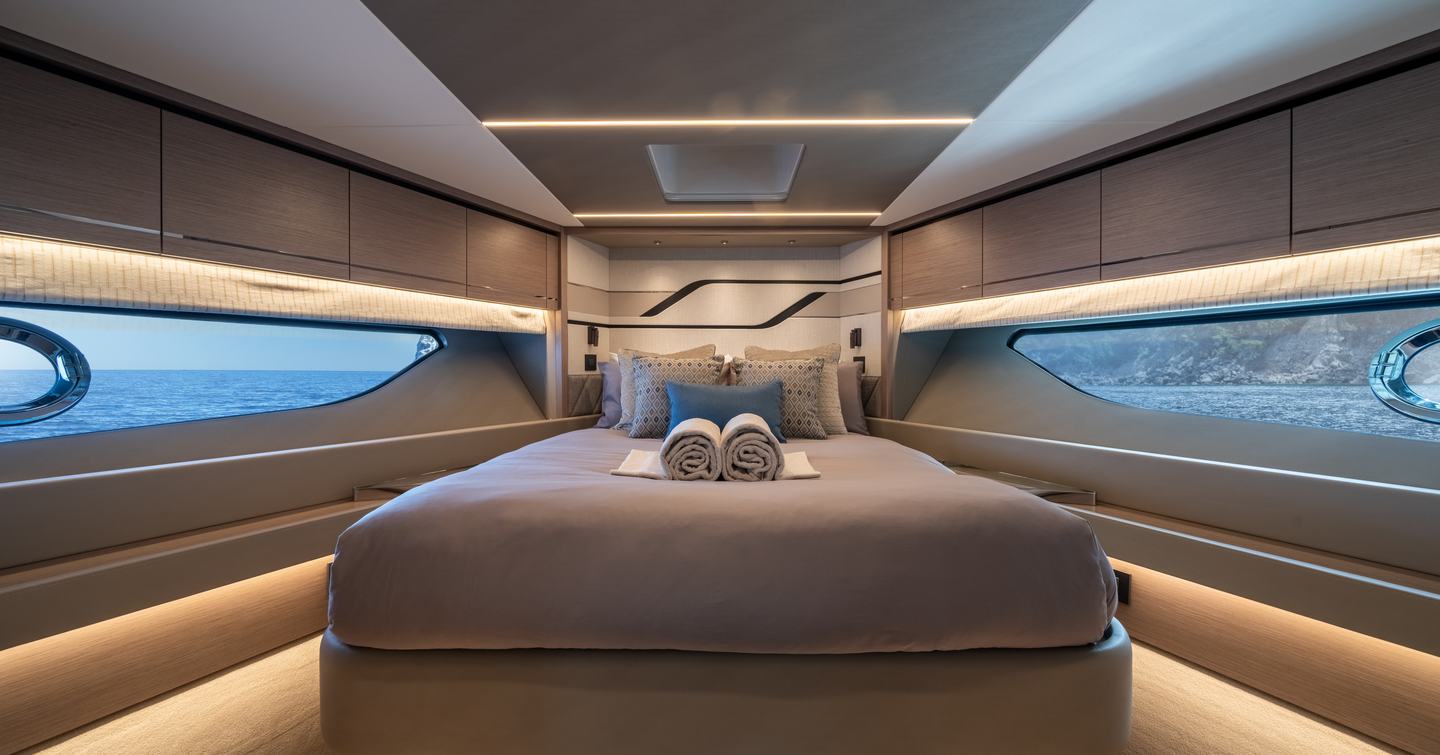
Moving aft on the starboard side is the dayhead, which mirrors the VIP’s finish and size, and also serves as the ensuite for the twin cabin. The twin sits lower in the hull, which means the ceiling height increases as the floor drops away, resulting in a surprisingly spacious feel. There’s proper storage here too, and subtle heating units have been fitted to keep the space comfortable in cooler conditions. Small details like the metal door handles stand out for their tactile quality and finish.
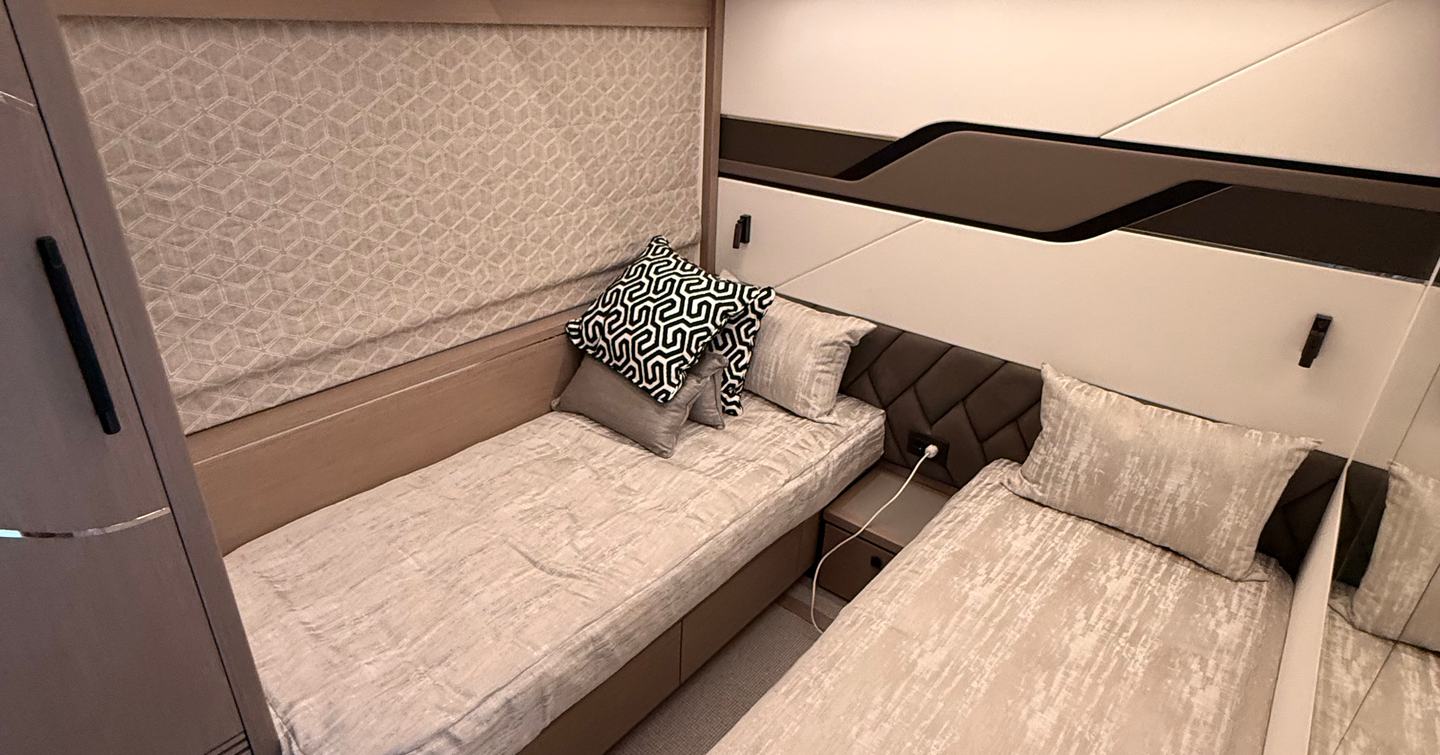
Crew Space
Access is via a sliding hatch, which leads down into a compact crew space. It’s arranged with over-and-under bunks and a small central area that gives just enough room to change. It's not designed for long-term living; it serves its purpose for short stays or occasional use. A washer-dryer is built in here too, making the most of the available footprint.
There’s a separate wet room fitted with a toilet, a shower, and a sink tucked behind the door. Realistically, this is a setup that suits a single deckhand or perhaps a captain on longer trips. The boat is clearly designed with owner-operation in mind, so crew accommodation isn’t a central focus.
That space is also shared with the tender garage, which naturally eats into the volume. But if you want a proper garage, something’s got to give - and in the 75 Sport Yacht's case, it’s the crew quarters.
This is where the 75 Sport Yacht comes into its own. At 40 knots, the sportsbridge helm is the place to be. Even cruising at 30 knots, which is comfortably within its range, you’re looking at roughly 300 nautical miles before needing to refuel.
It’s a helm suited for a fast cruising yacht as well, not just a wheel and a pair of throttles. Twin 40.6cm (16in) MFDs sit front and centre, flanked by two helm seats and backed up by joystick controls, thruster repeaters, and digital switching through the CM8 system. Trim tabs are traditional here - no auto systems, just straightforward adjustment.
One standout feature is the Perspex deflector. A simple bit of design, but exactly what you need on a low-profile boat like this. Slide it up, and it sends the breeze over your head rather than hitting you straight in the face.
Visibility forward is excellent, with a clear view down the bow and to the sunroof. As with all models in this series, there’s a choice: the Predator version gives you a vast opening sunroof, while the Sport Yacht adds the upper deck. If you want the extra driving position, the Sport Yacht is the one to go for.
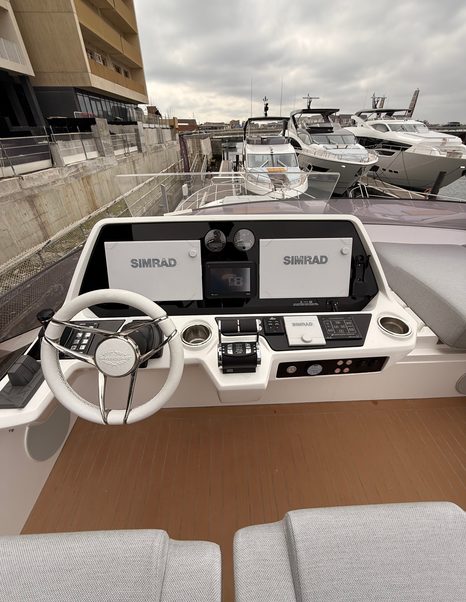
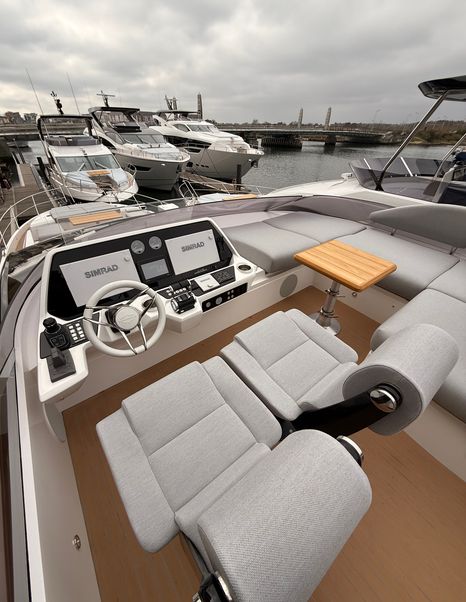
At the lower helm, twin leather helm chairs are nicely bolstered and fully adjustable, with the throttles, joystick, and independent proportional control for both bow and stern thrusters in reach. The setup includes twin 48.26cm (19-inch) Simrad MFDs, with engine instrumentation offset to port, radar display to starboard, and a CM8 repeater also within view. There’s also an induction phone charger, cup holders, and all the essentials neatly laid out.
A side door gives direct access to the side deck, making communication with the crew and movement easy. Sightlines are solid too. It’s not a one-piece windscreen, but the mullions are reasonably slim, so visibility stays clean across the bow. There’s also a small sunroof overhead - not as large as the one fitted to the Predator 75, but it still brings in some light and a bit of airflow.
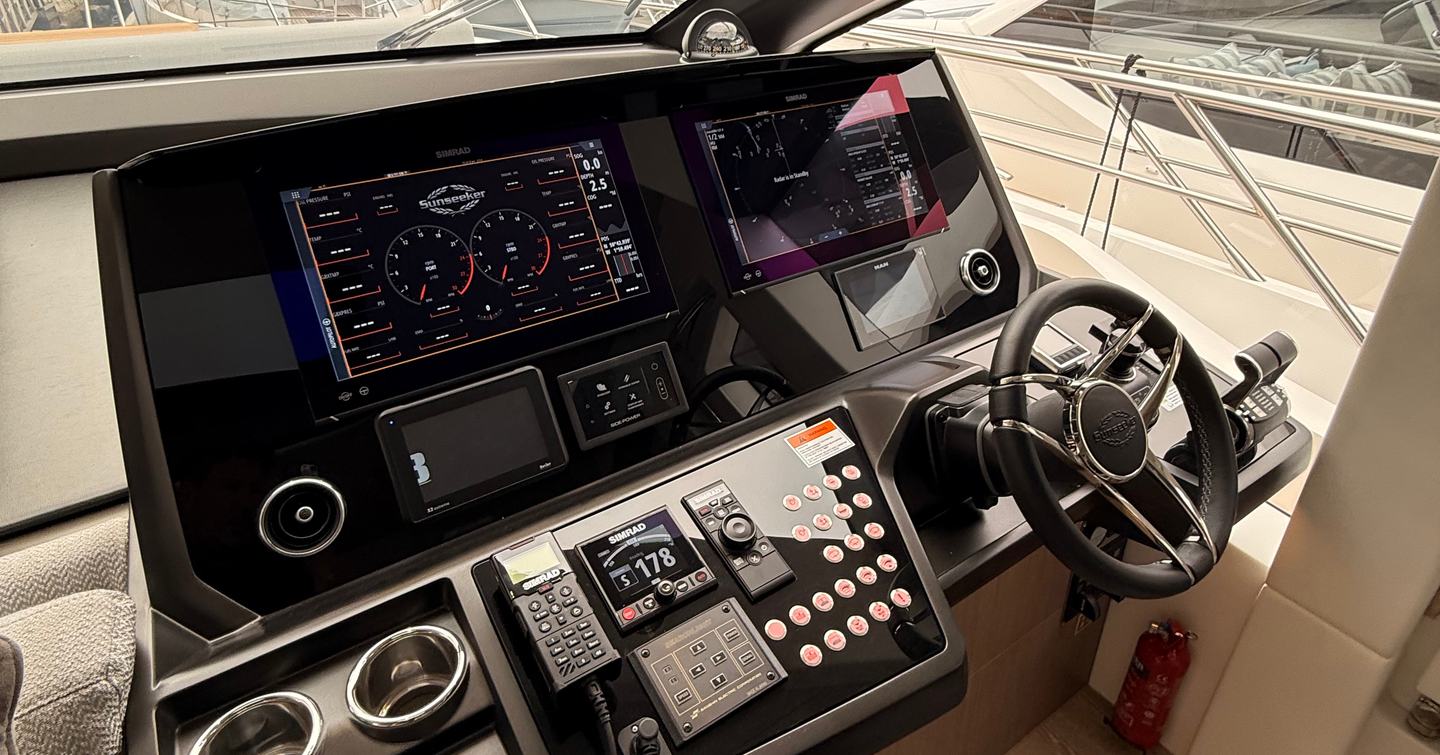
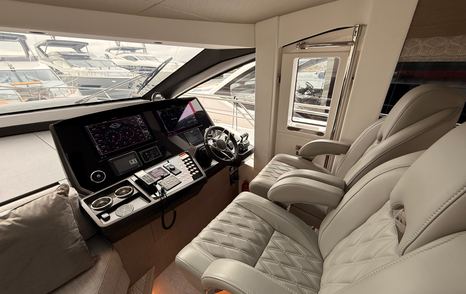
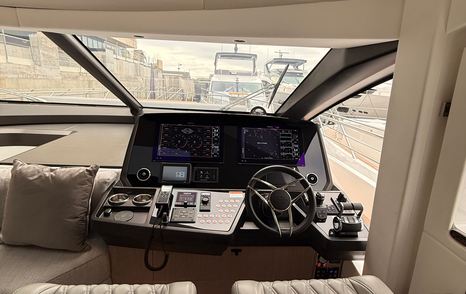
Aft, there's a hydraulic bathing platform that works in tandem with a starboard-side tender garage large enough to house a Williams 395. The split in the transom makes the layout clear - tender garage to starboard, crew cabin to port.
There’s symmetrical access up into the cockpit from both sides, but most will gravitate toward the port side. That’s partly because the cockpit seating dominates the space once you’re up there. It’s a U-shape arrangement, comfortably seating 12, but in doing so, it restricts through-access along the starboard side. The cushion at that end can be removed to ease passage, though the layout prioritises social space over walkaround flow.
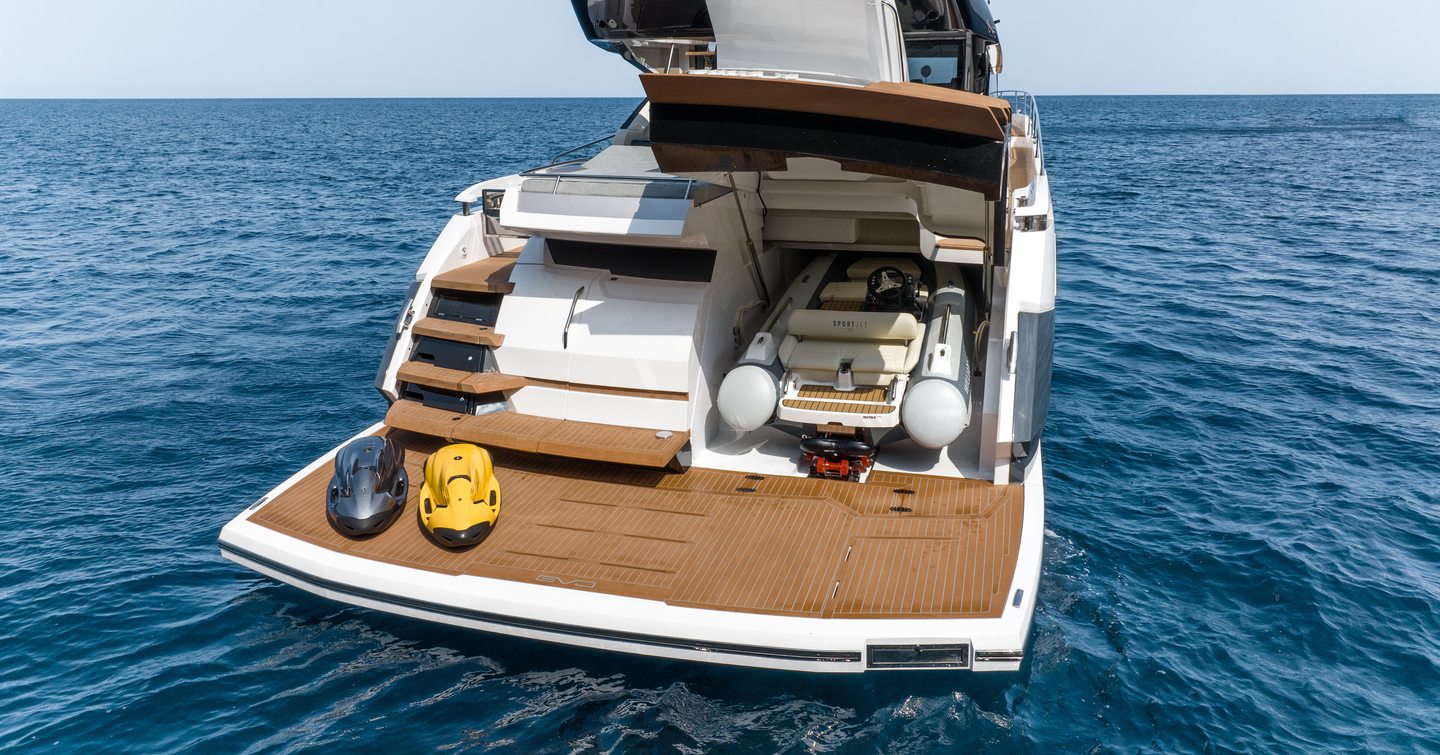
There are some lovely details around the aft platform - a socket in the deck for an overhead shower, plus a pull-out rinse shower on the port side by the top step. Just below, the passerelle extends when moored stern-to, and beneath that, the shore power connections are hidden cleanly out of sight to keep the aft deck uncluttered.
Aft of the cockpit seating is pure sunbathing space. A bimini can be fitted to extend from the backrest to give shade. A large cockpit table sits at the centre, folding out to span the space and easily accommodate the full complement of guests. Opposite, the wet bar is fitted with a sink and fridge - no grill here, though one is fitted up top on the sportsbridge.
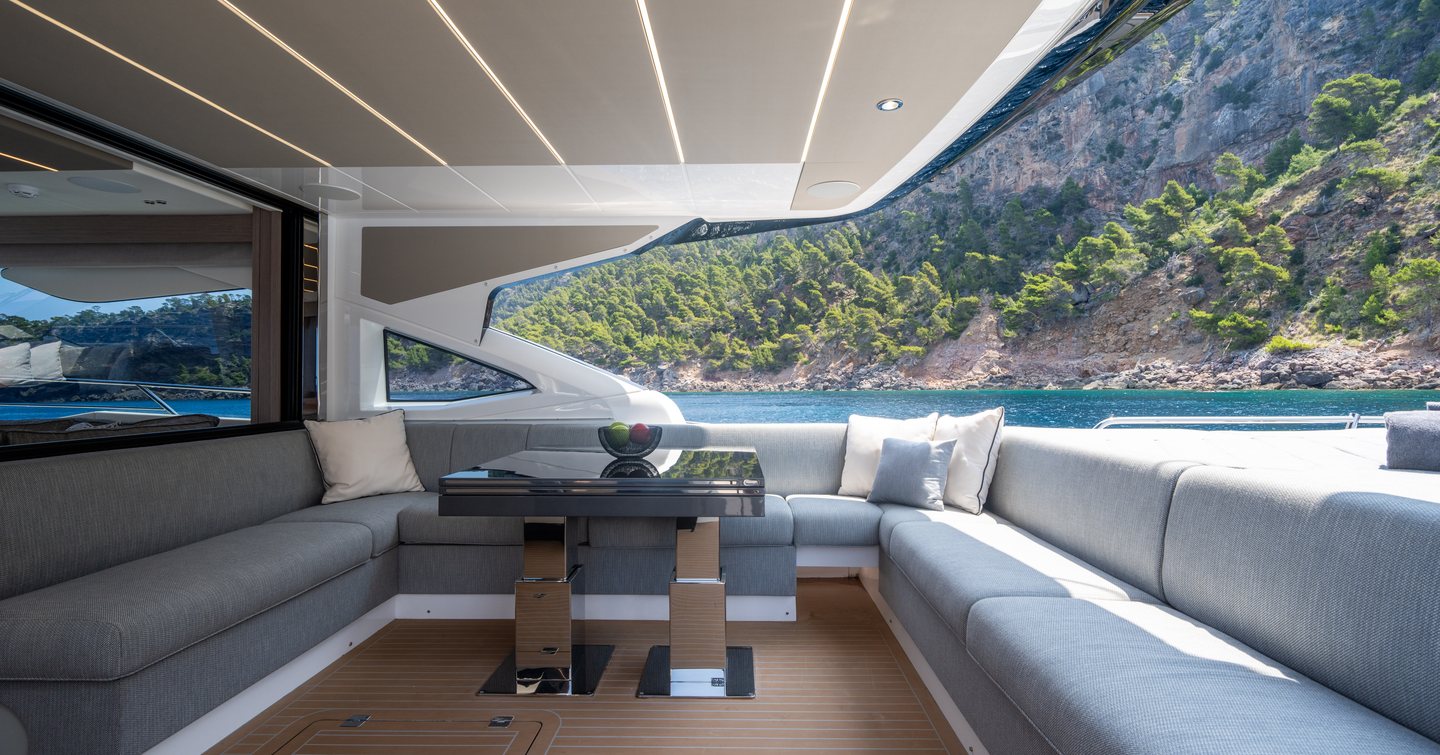
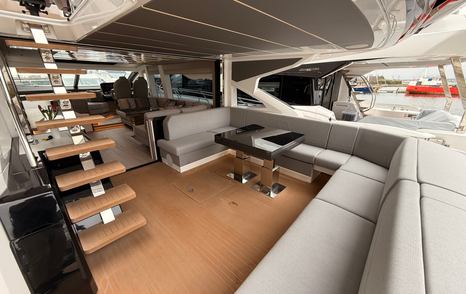
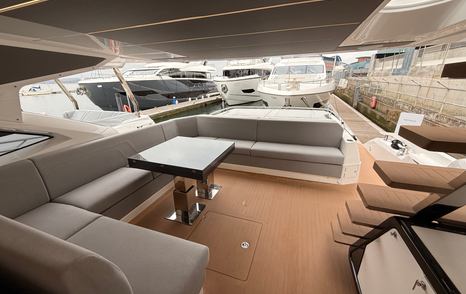
The 75 Sport Yacht can be fitted with an optional Aventix joystick system, which integrates with both thrusters and shafts to provide joystick control. A third docking station has been added aft, alongside the lower and upper helm positions. It’s a useful setup for stern-to-mooring, as this aft station provides clear sightlines across the bathing platform and a direct view forward through the windscreen. Communication with the crew is easy from here too, so it's a genuinely practical spot to work the boat from. For owner-operators especially, it’s an option worth considering.
As for the decking, this particular boat features synthetic teak with white caulking. It’s a matter of preference, but black caulking would arguably lift the look and be easier to keep clean over time - the white tends to show dirt quickly.
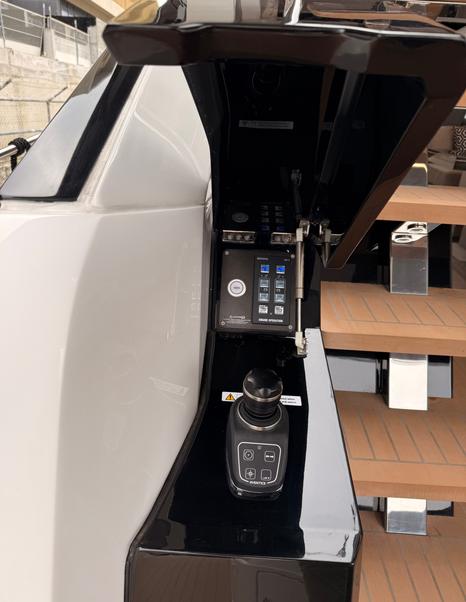
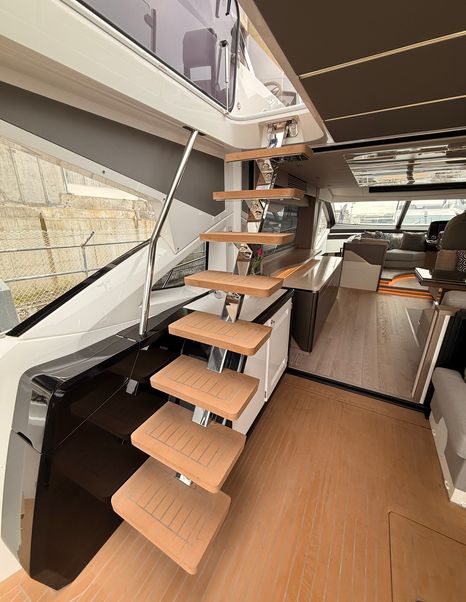
Side Decks & Foredeck
The side decks on the 75 Sport Yacht are nice and wide, so no need to shuffle along with one foot in front of the other. Port and starboard side decks mirror each other, including the side access door into the helm. But where the passage aft narrows, there's no walkthrough because of the seating in the cockpit - you either step over the backrest or drop down to the transom and walk along the ridge of the swim platform. Even with the platform lowered, it’s still accessible, and from there, it’s a short step back up to get to the cockpit.
The side decks open up to a foredeck that's a very usable space. It’s exposed by default, though there’s the option of a canopy with removable poles. The layout balances lounging and dining, with a full-sized table, quite large for a foredeck, flanked by forward-facing seating. It’s a lovely spot for lunch or drinks for two, and when you want to stretch out, a pram-hood-style shade covers the sunpads.
Just ahead, there’s more sunbathing space with adjustable backrests that lift to create forward-facing seating. Both sides have deep storage lockers best for covers and lines, though not quite big enough for fenders. Right up at the bow, the separated anchor hatch is deep and well-organised, with space for fenders and a long run of chain.
A couple of fridge drawers have been worked into the foredeck too, built into the long bench units to port and starboard. Great on hot days - cold drinks to hand and no need to trek back to the galley.
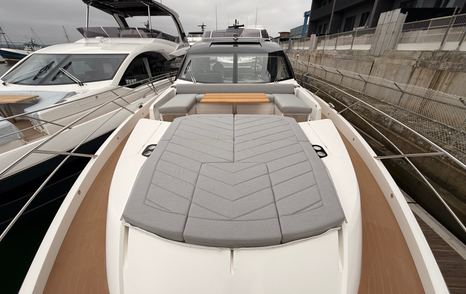
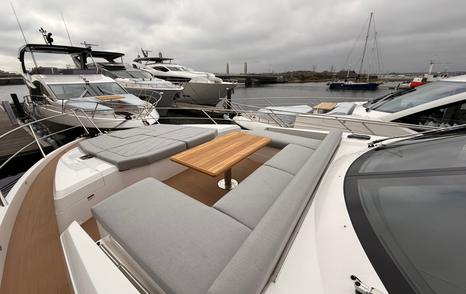
Sportsbridge
Accessed via a wide staircase with shallow, easy steps, the upper deck on the 75 Sport Yacht isn't a full flybridge, but you still get a surprising amount of usable space at this level. The teak table and wood detailing out in the Med are going to take a beating, so a set of covers would be a wise investment. Still, it looks the part.
Glass balustrades along the sides lend a clean, contemporary edge, and although there’s no hardtop option to keep the yacht’s sleek profile low, a hydraulic bimini folds behind the wet bar and can be deployed when needed. The wet bar itself is positioned at the aft end and equipped with a grill, sink, ice maker, and a top-loading fridge built in just behind.
At the aft end, there’s a convertible area that works as either a sunbathing space or extra seating. The backrest is mounted on a flip mechanism, so it can face forward to support the dinette or tilt back to extend the sun pad.
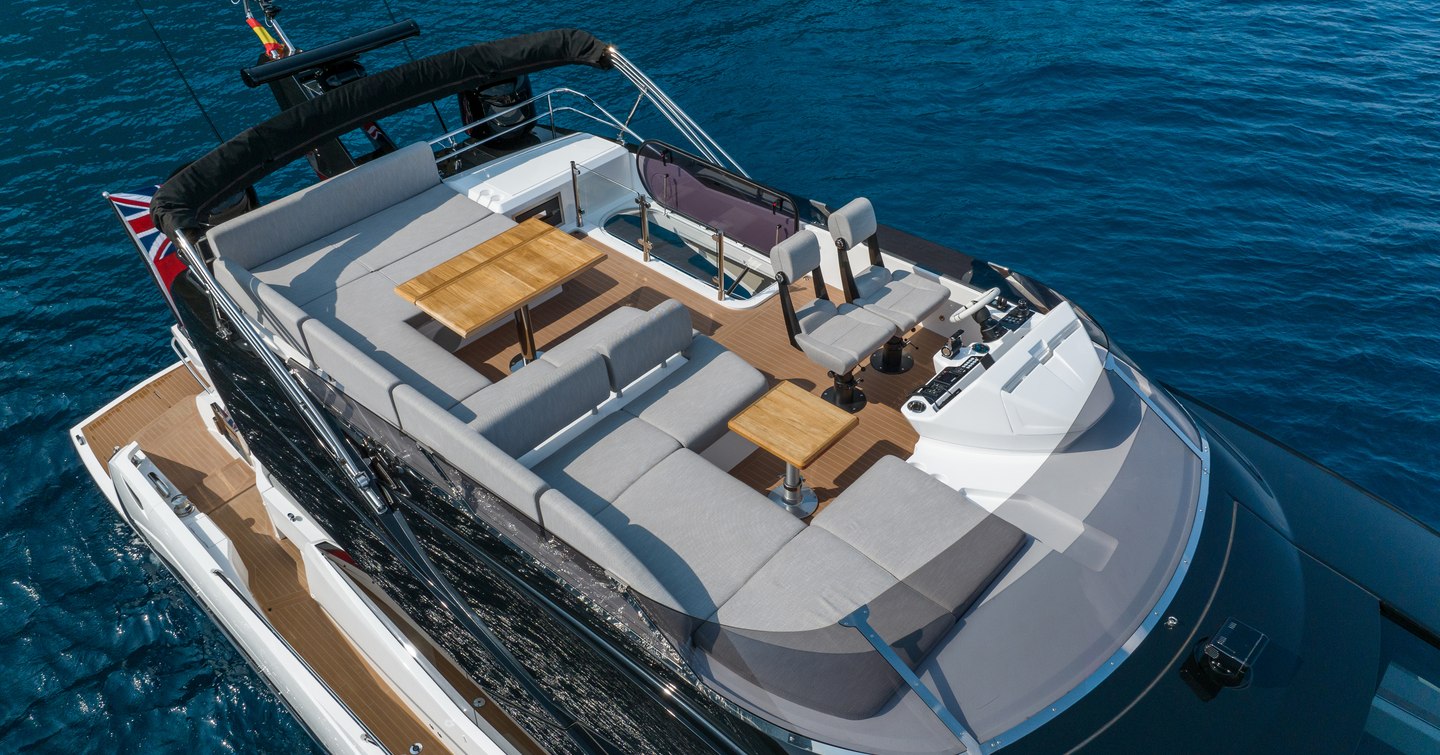
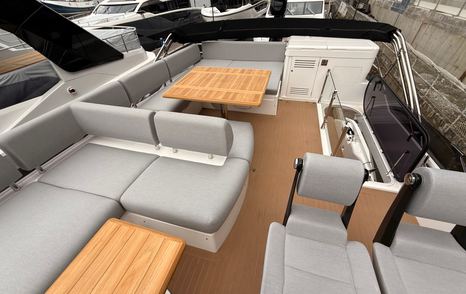
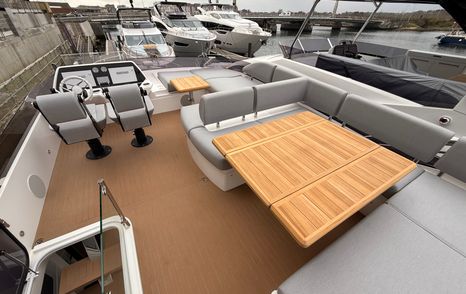
Access to the engine room is via an integrated cockpit hatch with a fixed ladder leading down. It’s a surprisingly spacious area given the size of the engines on board. The 75 Sport Yacht is running twin MAN V12s, but there’s still full standing headroom between them, so routine visual checks aren't hard to do.
There are two generators fitted - one mounted to starboard and the second positioned aft, closer to the steering gear. The hydraulic pack is located overhead, managing systems such as the thrusters, windlass, and the fin stabilisers. Despite the amount of machinery, the space is bright and sensibly arranged, with clear access to key components.
Sound insulation can be seen in here, and it is extensive, helping to temper that 24-cylinder output when cruising at 30 knots. There’s a degree of intrusion from the tender garage above, but given the yacht’s size, it doesn’t significantly impact space or access.
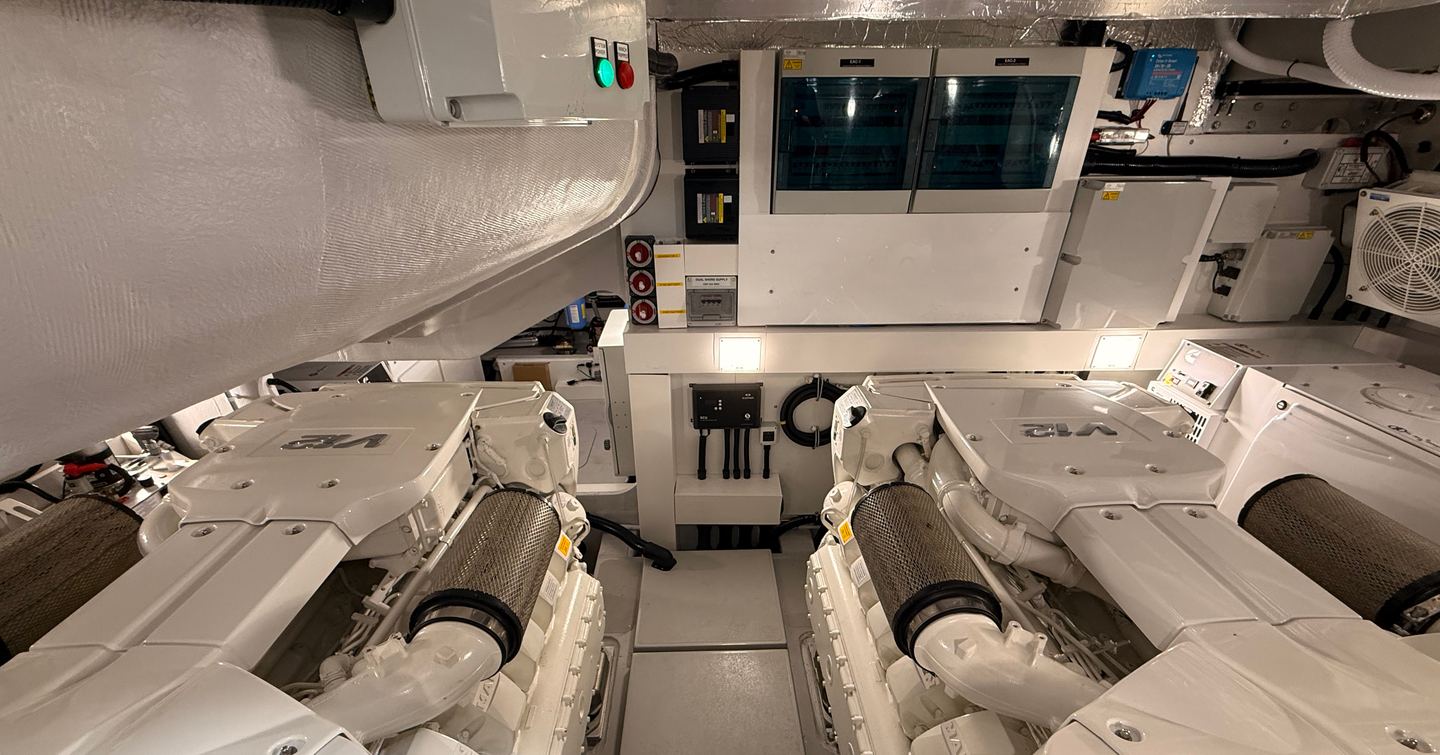
A 75 Sport Yacht to the specification of the boat we saw will cost in the region of £4,000,000 ex VAT (correct at time of writing).
This includes most of the cost options you'd want to create a 'turn-key' package, such as the larger 1,900hp engines, tropical air-conditioning, passerelle, bow and sternthrusters, upgraded navigation package, Performance AV package, twin generators (27kw & 11kw), and Sleipner fin stabilisers.
Our Verdict
With the Sunseeker range diversifying - and possibly not always that successfully - the 75 Sport Yacht feels like an old-school Sunseeker in the best possible way. Fast and sexy, it's a proper head turner with mountains of power that allows you to cruise fast but also pull the throttle back and cover a decent range. It's also very well built and manages to be modern without feeling like form is creeping in over function. Big enough to be very comfortable but manageable for an owner to run, it feels like a real sweet spot in the range.
Reasons to Buy
- Fast! 40-knot top speed
- Wraparound cockpit seating
- Full-beam owner's cabin
Things to Consider
- No hardtop
- Small crew quarters
Looking to own a Sunseeker 75 Sport Yacht? Use YachtBuyer’s Market Watch to compare all new and used Sunseeker 75 Sport Yachts for sale worldwide. You can also order a new Sunseeker 75 Sport Yacht, customized to your exact specifications, with options for engine choice and layout configuration. Alternatively, explore our global listings of new and used yachts for sale and find your perfect yacht today!
Rivals to Consider
The sportsbridge layout really comes into its own on yachts over 20 meters - not quite the scale of a full flybridge, but still an actual upper deck that's enjoyable and well worth having.
A strong rival in this space is the stylishly built Princess S72, which follows a similar format to Sunseeker’s interpretation. It tops out at 36 knots with smaller 1,650hp MAN engines and weighs in at 55 tonnes - a figure that speaks to the quality of the hull. Inside, it features a four-cabin layout with the galley positioned aft and a separate dining space amidships.
Azimut also has two models that land in the same conversation. The Azimut S7, a little shorter at 22 meters, runs on triple IPS drives and hits about 35 knots. Its interior brings the galley up to the main deck, unusually forward near the helm, and includes four cabins. Then there’s the Azimut S8, slightly longer at 25 meters, with a smaller sportsbridge but a generous main deck lounge and dining area, four cabins below, and the galley tucked down as well.
For something with a bit more GT flair, the Riva 76 Perseo Super is hard to ignore. It’ll do 37 knots and matches sharp performance with striking design. The three-cabin layout has all the yacht polish you’d expect, with a strong hint of supercar styling throughout - a serious contender for those wanting style with substance.
Considering a new yacht? Explore Sunseeker's entire current range to find the model that best suits your needs, and compare it with alternatives from competitors to ensure you make the perfect choice.
Specifications
- Builder Sunseeker
- Range Performance
- Model 75 Sport Yacht
- Length Overall 75' 8"
- Beam 17' 8"
- Draft(full load) 6' 2"
- Hull GRP
- Cabins 3
- Berths 6
- Crew 2
- Yacht Type (Primary) Sportsbridge
- Use Type (Primary) Cruising
- Cruising Speed
- Max Speed
- Fuel Capacity 1,268 Gallons
- Fresh Water Capacity 211 Gallons
- Engine Model 2x MAN V12-1550
- Engine max range (speed type) 900 (nm)
Interested in a 75 Sport Yacht?
NEW Build
Find your local dealer for a personalised, no-cost consultation
or just request
Brochures & Pricing
Used & In Stock
Looking for a ready-to-go 75 Sport Yacht or pre-owned options? Explore all inventory of the 75 Sport Yacht available worldwide
